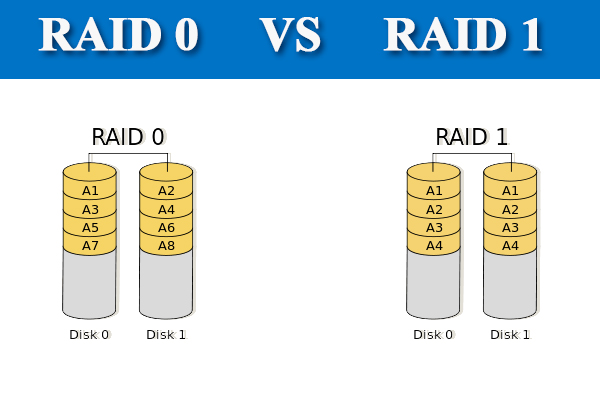Here are frequently asked questions (FAQs) on RAID 1 and RAID 10 configurations and their usage:
What is RAID 1?
RAID 1 is a disk mirroring configuration where data is duplicated exactly on two drives. This provides fault tolerance because if one drive fails, the other contains an exact copy of the data. However, RAID 1 requires twice the storage capacity since data is fully duplicated.
What is RAID 10?
RAID 10 (also called RAID 1+0) combines disk mirroring (RAID 1) and disk striping (RAID 0). It requires a minimum of four drives. Data is striped across mirrored pairs, offering both improved performance and redundancy. RAID 10 can tolerate one drive failure in each mirrored pair without data loss.
How does RAID 10 differ from RAID 1?
| Feature | RAID 1 | RAID 10 |
|---|---|---|
| Minimum drives | 2 | 4 |
| Data protection | Mirroring (full copy) | Mirroring + striping |
| Performance | Read speed improved; write speed similar to single drive | Improved read/write speeds due to striping |
| Storage efficiency | 50% (half capacity used for mirror) | 50% (half capacity used for mirrors) |
| Fault tolerance | Can tolerate 1 drive failure | Can tolerate 1 drive failure per mirrored pair |
| Use case | Simple redundancy | High performance + redundancy for critical systems |
What are the advantages of RAID 10 over RAID 1?
- Better performance: RAID 10 offers faster read and write speeds due to striping.
- Higher fault tolerance: RAID 10 can sustain multiple drive failures as long as no mirrored pair loses both drives.
- Suitable for I/O-intensive applications: Ideal for databases, email servers, and web servers requiring high uptime and speed.
What are the disadvantages of RAID 10?
- Cost: Requires at least four drives and halves usable storage capacity.
- Complexity: Slightly more complex to set up than RAID 1.
- No parity: Unlike RAID 5 or 6, RAID 10 does not use parity, so it requires more drives for redundancy.
How to set up RAID 1 and RAID 10 in Windows 10?
- RAID 1: Create a mirrored volume between two drives using Disk Management.
- RAID 10: Create two RAID 1 mirrored volumes first, then create a striped volume across these mirrored sets. This requires at least four drives.
Is RAID 10 better than RAID 01?
Yes, RAID 10 is generally preferred over RAID 01 because it is simpler to set up and offers better fault tolerance. RAID 10 can continue operating after a single drive failure in each mirrored pair, whereas RAID 01 has lower fault tolerance.
Best practices for RAID 1 and RAID 10 usage
- Use identical drives (same make, model, and capacity) for best performance and reliability.
- RAID is not a substitute for backups; maintain regular backups separately.
- Monitor drive health regularly using software tools.
- Consider hardware RAID controllers for mission-critical systems to improve performance and management.
Summary
- RAID 1 is simple mirroring for redundancy with two drives.
- RAID 10 combines mirroring and striping for better performance and fault tolerance but requires at least four drives.
- RAID 10 is preferred for high-performance, mission-critical environments.
- Both configurations halve usable storage due to mirroring.
- Proper setup and maintenance are essential for reliability.
These configurations are widely used in business and enterprise environments where data protection and uptime are critical.




















WebSeoSG offers the highest quality website traffic services in Singapore. We provide a variety of traffic services for our clients, including website traffic, desktop traffic, mobile traffic, Google traffic, search traffic, eCommerce traffic, YouTube traffic, and TikTok traffic. Our website boasts a 100% customer satisfaction rate, so you can confidently purchase large amounts of SEO traffic online. For just 40 SGD per month, you can immediately increase website traffic, improve SEO performance, and boost sales!
Having trouble choosing a traffic package? Contact us, and our staff will assist you.
Free consultation